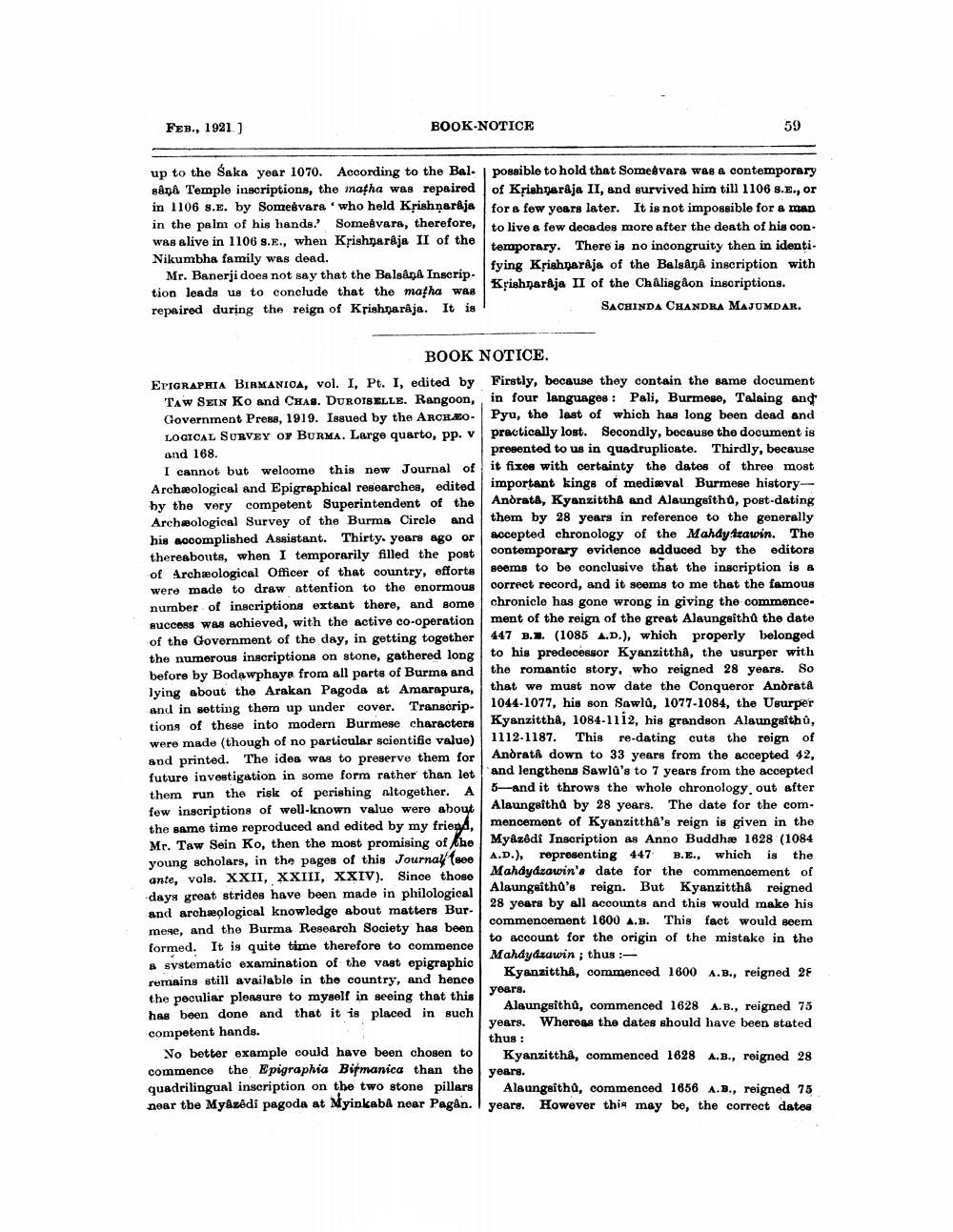________________
FEB., 1921)
BOOK-NOTICE
59
up to the Saka year 1070. According to the Bal. possible to hold that Somesvara was a contemporary såna Temple inscriptions, the matha was repaired of Krishnaraja II, and survived him till 1106 S.E., or in 1106 S.E. by Somesvara who held Krishnaraja for a few years later. It is not impossible for a man in the palm of his hands. Some vara, therefore,
to live a few decades more after the death of his oon. was alive in 1106 S.E., when Krishnaraja II of the
temporary. There is no incongruity then in identi. Nikumbha family was dead. Mr. Banerji does not say that the Balsa A Inscrip
fying Krishnarja of the Balsånå inscription with tion leads us to conclude that the matha was I kishparaja ll of the Chalisgaon inscriptions. repaired during the reign of Krishnaraja. It is
SACHINDA CHANDRA MAJUMDAR.
BOOK NOTICE. EPIGRAPHIA BIRMANIOA, vol. I, Pt. I, edited by Firstly, because they contain the same document
TAW SEIN Ko and CHAS. DUROTSELLE. Rangoon, in four languages: Pali, Burmese, Talaing and Government Press, 1919. Issued by the ARCHAEO
Press, 1919. Issued by the ARCHAEO- Pyu, the last of which has long been dead and LOGICAL SURVEY OF BURMA. Large quarto, pp. v practically lost. Secondly, because the document is and 168.
presented to us in quadruplicate. Thirdly, because I cannot but welcome this new Journal of it fixes with certainty the dates of three most Archæological and Epigraphical researches, edited
graphical researches edited important kings of medieval Burmese historyhy the very competent Superintendent of the Andrata, Kyanzittha and Alaungsitha, post-dating Archeological Survey of the Burma Circle and them by 28 years in reference to the generally his accomplished Assistant. Thirty years ago or accepted chronology of the Mahdy trawin. The thereabouts, when I temporarily filled the post
contemporary evidence adduced by the editors of Archæological Officer of that country, efforts seems to be conclusive that the inscription is a were made to draw attention to the enormous correct record, and it seems to me that the famous number of inscriptions extent there, and some chronicle has gone wrong in giving the commence. RUCCOns was achieved, with the active co-operation ment of the reign of the great Aloungeith the date of the Government of the day, in getting together 447 B... (1085 A.D.), which properly belonged the numerous inscriptions on stone, gathered long to his predecessor Kyanzitthâ, the usurper with before by Bodawphaya from all parts of Burma and
the romantic story, who reigned 28 years. So lying about the Arakan Pagoda at Amarapura, that we must now date the Conqueror Andrata and in setting them up under cover. Transcrip- 1044-1077, his son Sawlû, 1077-1084, the Ugurper tions of these into modern Burmese characters Kyanzittha, 1084.1112, his grandson Alsungaith, were made (though of no particular scientific value) 1112-1187. This re-dating cuts the reign of and printed. The idea was to preserve them for Andrata down to 33 years from the accepted 42, future investigation in some form rather than let and lengthens Sawla's to 7 years from the accept them run the risk of perishing altogether. A
5-and it throws the whole chronology out after fow inscriptions of well-known value were about Alaungaith by 28 years. The date for the comthe same time reproduced and edited by my friend, mencement of Kyanzittha's reign is given in the Mr. Taw Sein Ko, then the most promising of the Myazódi Inscription as Anno Buddhse 1628 (1084 young scholars, in the pages of this Journay (see A.D.), representing 447 B.E., which is the
Mahdydzowin's date for the commencement of ante, vols. XXII, XXIII, XXIV). Since those
Alaungeithu's reign. But Kyanzitthå days great strides have been made in philological
reigned
28 years by all accounts and this would make his and archaeologioal knowledge about matters Bur.
commencement 1600 A.B. mese, and the Burma Research Society has been
This fact would seem formed. It is quite time therefore to commence
to account for the origin of the mistake in the
Mahdydzowin; thus :& systematic examination of the vast epigraphic remains still available in the country, and hence
Kyanaitthâ, commenced 1800 A.B., reigned 2F
years. the peculiar pleasure to myself in seeing that this has been done and that it is placed in such
Alsungsithù, commenced 1628 A.B., reigned 75
years. Whereas the dates should have been stated competent hands.
thus : No better example could have been chosen to Kyanzittha, commenced 1628 A.B., reigned 28 commence the Epigraphia Birmanica than the years. quadrilingual inscription on the two stone pillars Alsungasthù, commenced 1656 A.B., reigned 75 near the Myazédi pagoda at Myinkabâ near Pagån. years. However thi, may be, the correct dates




